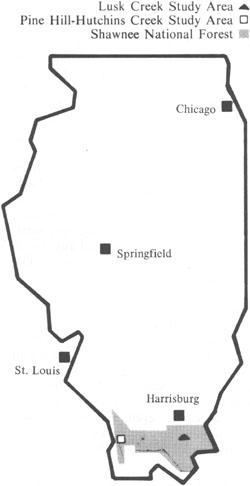
By BARBARA DOE
Graduate assistant, environments and
People Program. Sangamon State University.
She directed the Wilderness Study
Project at SSU in summer 1974 and is
now working with the Sangamon Wilderness
Group to develop a management proposal
study on Pine HillsHutchins Creek Study
area for submission to the Forest Service
and Congress.
May consider two tracts in Shawnee Hills for 'wilderness areas' under U.S. bill

MAN has tamed the prairies and forests of Illinois; even so, a few wild lands still remain hidden in the Shawnee Hills of southern Illinois. Efforts to preserve portions of these natural areas have resulted in their inclusion in the Eastern Wilderness Bill, under consideration in the 93rd Congress. The bill would establish 19 federal wilderness areas in national forests east of the Rocky Mountains. An additional 40 areas, including two tracts in southern Illinois, would be studied by the Forest Service to determine if they qualify for wilderness classification.
The Eastern Wilderness Bill was passed by the Senate in May 1974. Debate still continues in the House Interior Committee over the companion bill, H.R. 13455. At the same time, residents surrounding the proposed study areas in Illinois contend that wilderness classification would have a negative effect on the local economy. Groups such as the Sierra Club counter that the last remaining wild lands in Illinois deserve study to determine their potential for wilderness designation.
Eastern Wilderness Bill
Conservationists support the Eastern
Wilderness Bill because, for the first
time, federal wilderness protection is
offered to portions of eastern national
forests. Under present Forest Service
management, all national forest lands
are subject to mining, timber cutting
and recreational development. But the
Wilderness Act of 1964 authorized
Congress to protect certain areas of
these national forests by designating
them as wilderness areas.
The Forest Service has not yet recommended to Congress any eastern lands for federal wilderness classification. This wilderness classification is in terpreted by the Forest Service to apply only to virgin lands which have not been lumbered or occupied by man. In 1970, only five of the 62 virgin wilderness areas were located east of the Rocky Mountains. There are none in Illinois.
In contrast to the strict Forest Service view, organizations such as the Wilderness Society interpret the Act as applying to all lands in an essentially wild slate. They argue that under the Forest Service classification, no lands would qualify for wilderness area status because man has in some way affected all parts of the country.
The Eastern Wilderness Bill specifically authorizes wilderness designation of previously disturbed lands in the East. These areas would be set aside as federal wilderness areas and allowed to return to their natural state. Camping, hunting, fishing and scientific study would be encouraged, while timber cutting, motorized vehicles and structural developments would be prohibited. The Eastern Wilderness Bill differs from the Wilderness Act in that mining in eastern areas would not be allowed.
Important question for Illinois
For citizens of Illinois, the important
question is: "What effect would the
Eastern Wilderness Bill have on
Illinois?" There are two Illinois tracts
among the 40 areas to be studied by
the Forest Service. These two areas,
Lusk Creek and Pine HillsHutchins
Creek, are located in the Shawnee
National Forest as shown on the
accompanying map.
Both study areas offer scenic features such as canyons, bluffs and mature forests seldom found in the Illinois landscape. Because of their remote nature, the tracts contain unique vegetation and wildlife. The canyon enclosing Lusk Creek provides an ideal habitat for rare mosses, ferns and lichens. In the Pine Hills-Hutchins
20/Illinois Issues/January 1975